Scotland's Wellbeing: national outcomes for disabled people
Analysis of the National Performance Framework (NPF) outcome indicators from the perspective of disability.
3. Communities
We live in communities that are inclusive, empowered, resilient and safe
What we know:
- Just over half of disabled people (55%) perceived their neighbourhoods as ‘very good’ places to live, the same as non-disabled people.
- Access to blue (rivers, lakes, coasts) and green (parks, hills, woods and countryside) space is lower for disabled people (60%) compared to non-disabled people (70%).
- In 2017/18, disabled people were slightly more likely to be victims of crime generally than non-disabled people (14.9% compared to 11.8%).
- Compared to non-disabled people, they were also more likely to be worried about certain specific crimes mentioned in the crime survey such as credit card or bank theft, stolen identity and vehicle vandalism.
National outcome
The communities outcome recognises that to be healthy and happy as a nation we must nurture and protect local resources, environments and communities who live in them. The vision includes a range of different aspects of communities including housing, planning and transport; affordable and accessible public services; access to greenspace and safe, cohesive communities which value diversity and support those in need.
National Performance Indicators
There are eight indicators in the communities component of the NPF. Four indicators are currently being developed:
- Social capital – No indicator at present
- Places to interact – No indicator at present
- Community land ownership – No indicator at present
- Loneliness – No indicator at present
The remaining four are available broken down by disability status:
- Perceptions of local area (percentage who rate their neighbourhood as a very good place to live)
- Access to green and blue space (proportion of adults who live within a 5 minute walk of their local green or blue space).
- Perceptions of local crime rate (percentage of adults who think crime in there are has stayed the same or reduced in the past 2 years).
- Crime victimisation (proportion of adults who have been a victim of one or more crime in the past year)
Perceptions of Local Area
According to the Scottish Household Survey[13] (SHS), just over half of the population perceived their neighbourhood to be a very good place to live. The relative proportions of non-disabled and disabled people with this perspective has been fairly consistent over time (see Figure 3.1). In 2015, 57% of non-disabled people perceived their neighbourhood as a very good place to live, compared to 55% of disabled people.
Figure 3.1 The percentage of adults who rate their neighbourhood as a very good place to live, by disability, from 1999-2015.
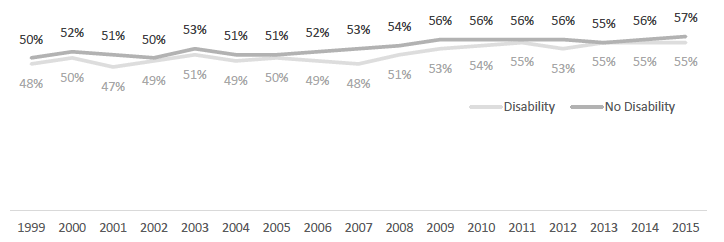
Source: Scottish Household Survey 1999-2015
Access to Green and Blue Space
“Access to green and blue space” is measured by the SHS using the greenspace question which defines greenspaces as “public green or open spaces in the local area, for example a park, countryside, wood, play area, canal path, riverside or beach”.[14] The SHS[15] indicates that, compared to non-disabled people, a smaller proportion of disabled people live within a five minute walk of their local green or blue space. In 2017, 60% of disabled people lived within a 5-minute walk of their local green or blue space. By comparison, 66% of those with non-limiting long-term conditions were in this situation, as were 70% of those with no limiting condition (see Figure 3.2).
Figure 3.2 Proportion of adults who live within a 5 minute walk of their local green or blue space, by disability, from 2013-17.
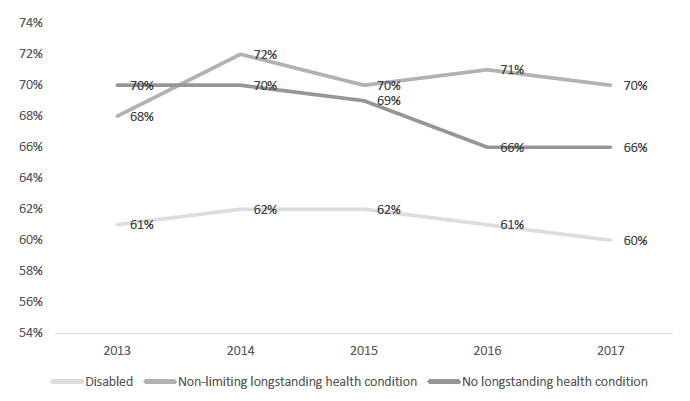
Source: Scottish Household Survey 2013-2017
Perceptions of Crime
This National Indicator looks at the proportion who believe the local crime rate has stayed the same or reduced (combined). In the 2017/18 Scottish Crime and Justice Survey (SCJS)[16] it was reported that 68% of disabled adults believed that crime had stayed the same or reduced, compared to 74% of non-disabled adults. In the same year, 26% of disabled adults thought the local crime rate had increased, compared to 21% of non-disabled adults (see Figure 3.3). There was no significant difference between those who believed that there was less crime.
Figure 3.3 Perceptions of changes in the local crime-rate in the last two years, by disability.
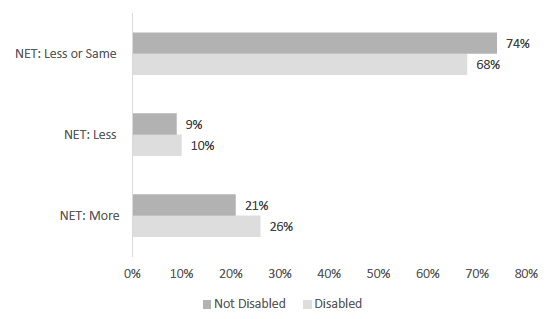
Source: Scottish Crime & Justice Survey 2017-18
Crime Victimisation
The SCJS also indicates that disabled adults were more likely to be victims of crime in 2017/18 than non-disabled adults. In this year, 14.9% of disabled people had been a victim of at least one crime, compared to 11.8% of the non-disabled people. Specifically, disabled people were more likely to experience property crime than non-disabled people, but there was no statistically significant difference for violent crime (Figure 3.4).[17]
Figure 3.4 Percentage of respondents who have been victims of crime, by crime type and disability.
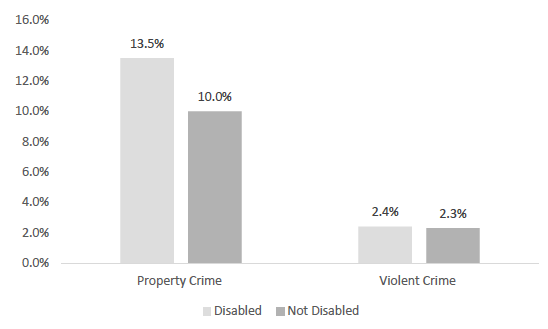
Source: Scottish Crime & Justice Survey 2017-18
This difference may also partially reflect that disabled people are more likely to live in areas of greater deprivation. In the 15% most deprived areas, 18% of survey respondents had been a victim of a survey crime, compared to 11.8% in the rest of the sample. At the same time, rates of both violent and property crime are significantly higher among the most deprived 15%, while only property crime was higher for disabled people.
In the longer term, evidence suggests that the incidence of crime among disabled people has decreased. Research from the EHRC based on the SCJS, found that in the 2008/09 – 2010/11 period disabled people were less likely to be victims of crime.
During this period, they report that 19.5% of non-disabled people were victims of crime, compared to 17.6% of disabled people.[18] By comparison, in 2012/13, there was almost no difference between the number of disabled and non-disabled people experiencing crime. While crime decreased significantly among non-disabled people between the baseline above and 2012/13 (to 16.9%), it did not significantly decline among disabled people, and was recorded at 17.1% in that period.[19]
Additional Indicators
Worry about crime and perceptions of crime likelihood
In the 2017/18 SCJS, disabled people were significantly more likely to be worried about a range of survey crimes, as shown in Figure 3.5. However, when participants were asked whether they thought these crimes were likely to happen to them in the next 12 months, these differences were less pronounced (Figure 3.6).
Figure 3.5 Percentage of participants in sample who are worried about specific crimes in 2017-18, by disability. All figures show statistically significant differences.
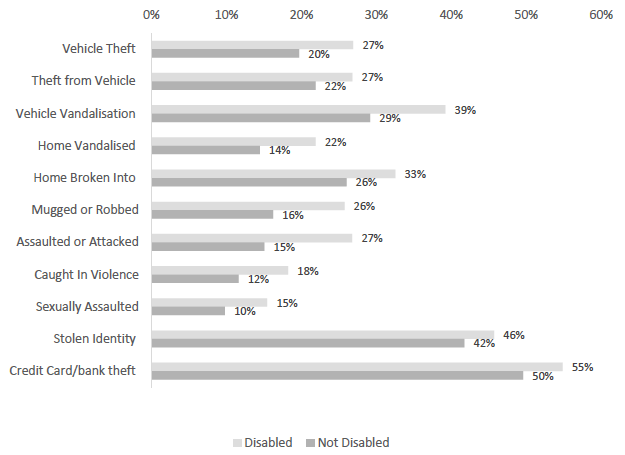
Source: Scottish Crime & Justice Survey 2017-18
Figure 3.6 Percentage of participants who believe specific crimes are likely to happen to them in the next 12 months, in 2017-18, by disability. Divided into significant and non-significant differences.
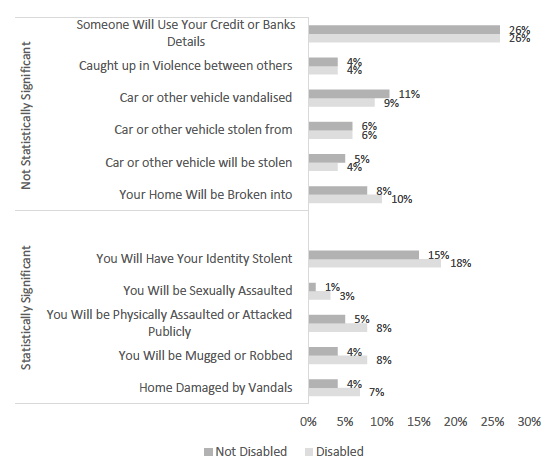
Source: Scottish Crime & Justice Survey 2017-18
Hate Crimes
In Scotland, the Crown Office reported 284 charges aggravated by disability prejudice in 2017-18, which is an increase of 51% on the previous year.[20] This type of aggravation has increased – with a small fall in 2016-17 – since it was introduced in 2010. The Crown Office reports a broad consensus that these crimes are under-reported. For comparison, there were 1,112 charges of aggravation of prejudice related to sexual orientation in 2017/18.
Concern has also been expressed about the escalation in reported hate crimes online in England and Wales. Following a Freedom of Information (FOI) request from the charity Leonard Cheshire, police forces reported that there had been a 33% increase in reported online hate crimes against disabled people between 2016/17 and 2017/18.[21] Following a parliamentary petition in 2017, the UK Government has conducted an enquiry into the online abuse of disabled people and considered whether online abuse should become a specific criminal offence.[22] However, it is unclear whether increases represent a greater number of incidents or increased reporting.
Evidence also suggests that people with long-term physical health conditions are more likely to experience discrimination and/or harassment.[23] The SHS, from 2013 to 2017, has found slightly higher rates of discrimination and harassment experienced by people with long-term health conditions when compared to those not reporting these[24] (see Figure 3.7).
Figure 3.7 Experience of discrimination and harassment by presence of a long-term physical/mental health condition, 2013-17.
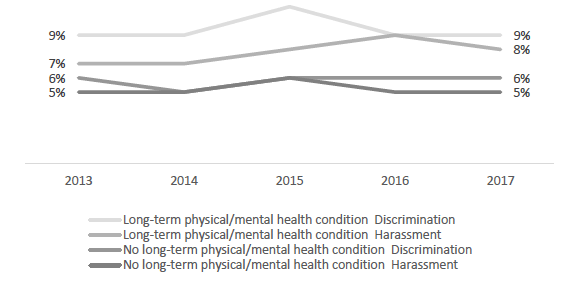
Source: Scottish Household Survey 2013-2017
Contact
Email: joseph.ritchie@gov.scot
There is a problem
Thanks for your feedback